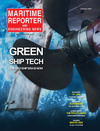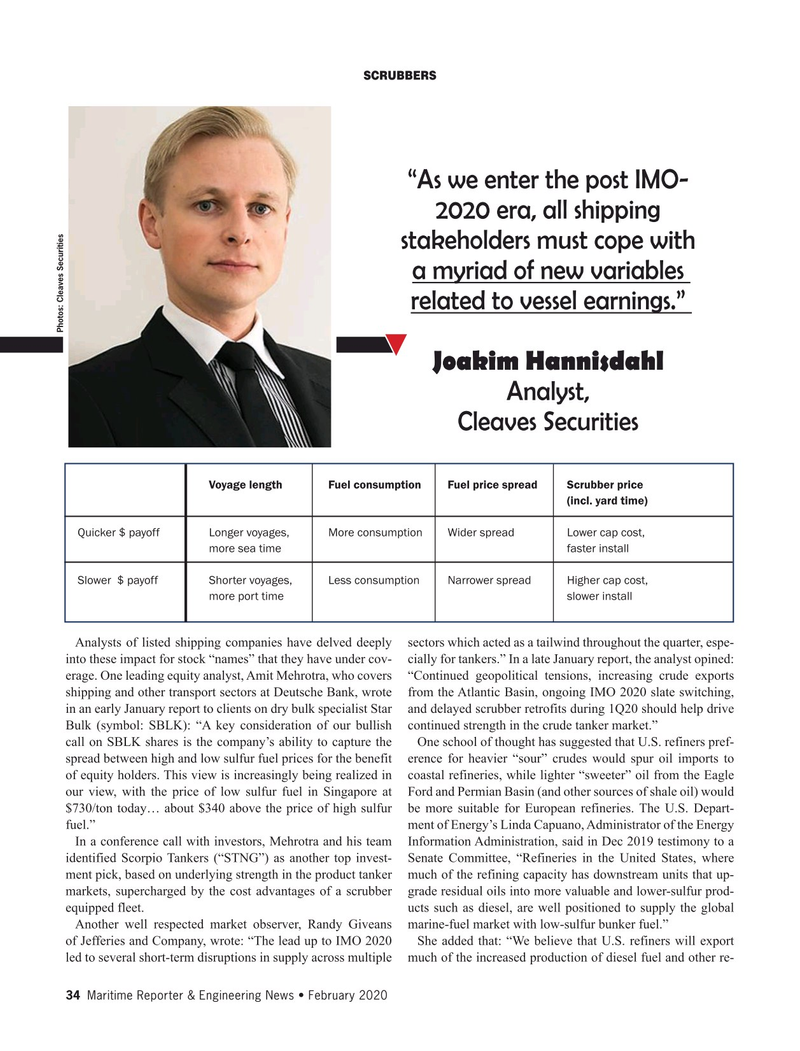
Page 34: of Maritime Reporter Magazine (February 2020)
Green Ship Technology
Read this page in Pdf, Flash or Html5 edition of February 2020 Maritime Reporter Magazine
SCRUBBERS “As we enter the post IMO- 2020 era, all shipping stakeholders must cope with a myriad of new variables related to vessel earnings.”
Photos: Cleaves Securities
Joakim Hannisdahl
Analyst,
Cleaves Securities Voyage length Fuel consumption Fuel price spread Scrubber price (incl. yard time)
Quicker $ payoff Longer voyages, More consumption Wider spread Lower cap cost, more sea time faster install
Slower $ payoff Shorter voyages, Less consumption Narrower spread Higher cap cost, more port time slower install
Analysts of listed shipping companies have delved deeply sectors which acted as a tailwind throughout the quarter, espe- into these impact for stock “names” that they have under cov- cially for tankers.” In a late January report, the analyst opined: erage. One leading equity analyst, Amit Mehrotra, who covers “Continued geopolitical tensions, increasing crude exports shipping and other transport sectors at Deutsche Bank, wrote from the Atlantic Basin, ongoing IMO 2020 slate switching, in an early January report to clients on dry bulk specialist Star and delayed scrubber retrofits during 1Q20 should help drive
Bulk (symbol: SBLK): “A key consideration of our bullish continued strength in the crude tanker market.” call on SBLK shares is the company’s ability to capture the One school of thought has suggested that U.S. refiners pref- spread between high and low sulfur fuel prices for the benefit erence for heavier “sour” crudes would spur oil imports to of equity holders. This view is increasingly being realized in coastal refineries, while lighter “sweeter” oil from the Eagle our view, with the price of low sulfur fuel in Singapore at Ford and Permian Basin (and other sources of shale oil) would $730/ton today… about $340 above the price of high sulfur be more suitable for European refineries. The U.S. Depart- fuel.” ment of Energy’s Linda Capuano, Administrator of the Energy
In a conference call with investors, Mehrotra and his team Information Administration, said in Dec 2019 testimony to a identified Scorpio Tankers (“STNG”) as another top invest- Senate Committee, “Refineries in the United States, where ment pick, based on underlying strength in the product tanker much of the refining capacity has downstream units that up- markets, supercharged by the cost advantages of a scrubber grade residual oils into more valuable and lower-sulfur prod- equipped fleet. ucts such as diesel, are well positioned to supply the global
Another well respected market observer, Randy Giveans marine-fuel market with low-sulfur bunker fuel.” of Jefferies and Company, wrote: “The lead up to IMO 2020 She added that: “We believe that U.S. refiners will export led to several short-term disruptions in supply across multiple much of the increased production of diesel fuel and other re- 34 Maritime Reporter & Engineering News • February 2020
MR #2 (34-49).indd 34 2/5/2020 11:29:00 AM

 33
33

 35
35
